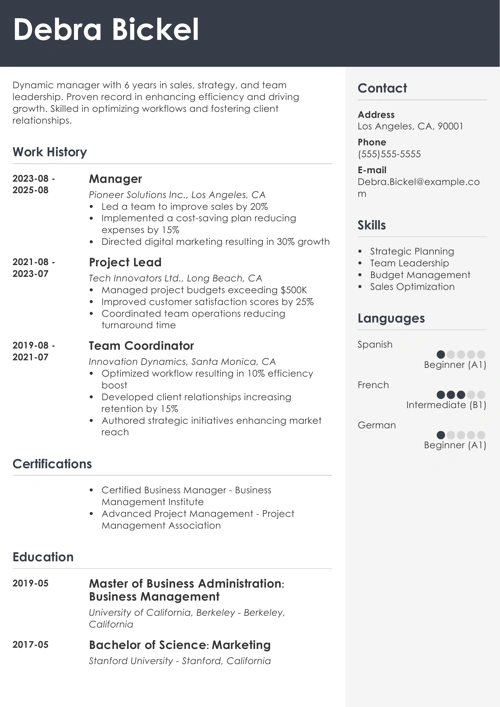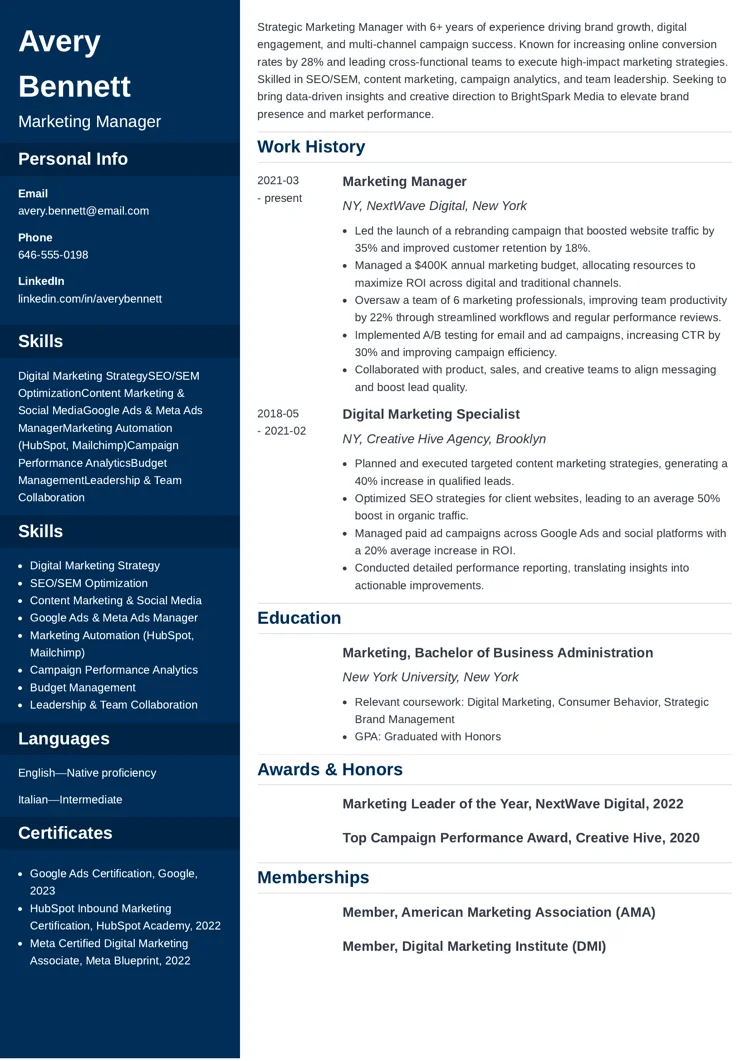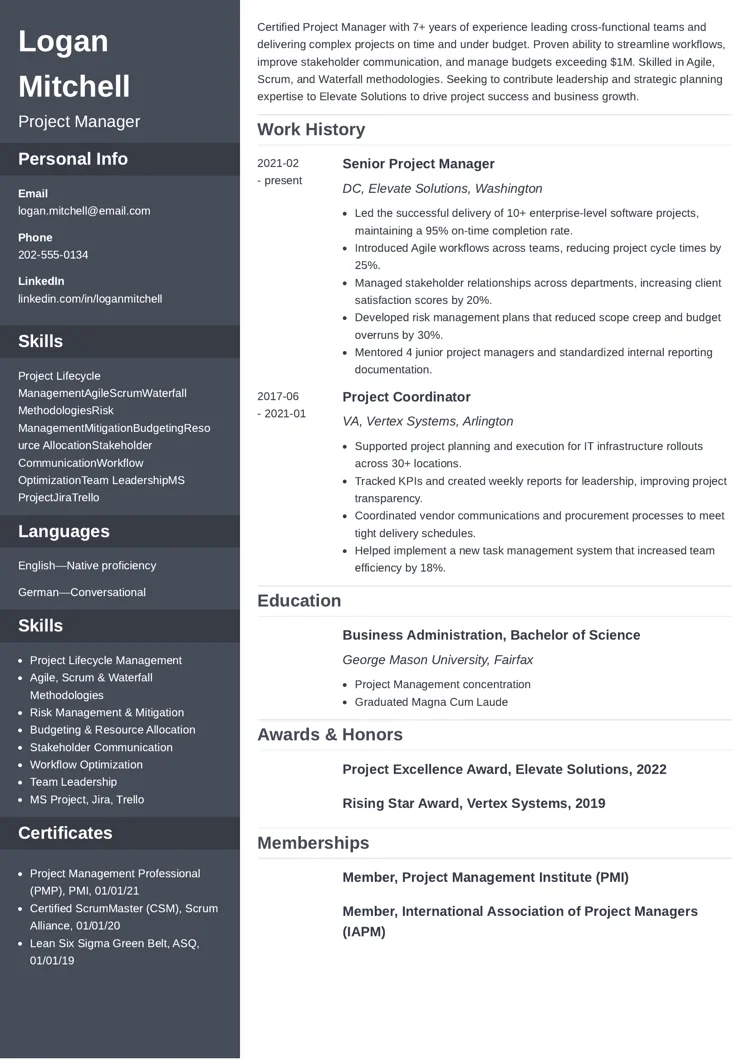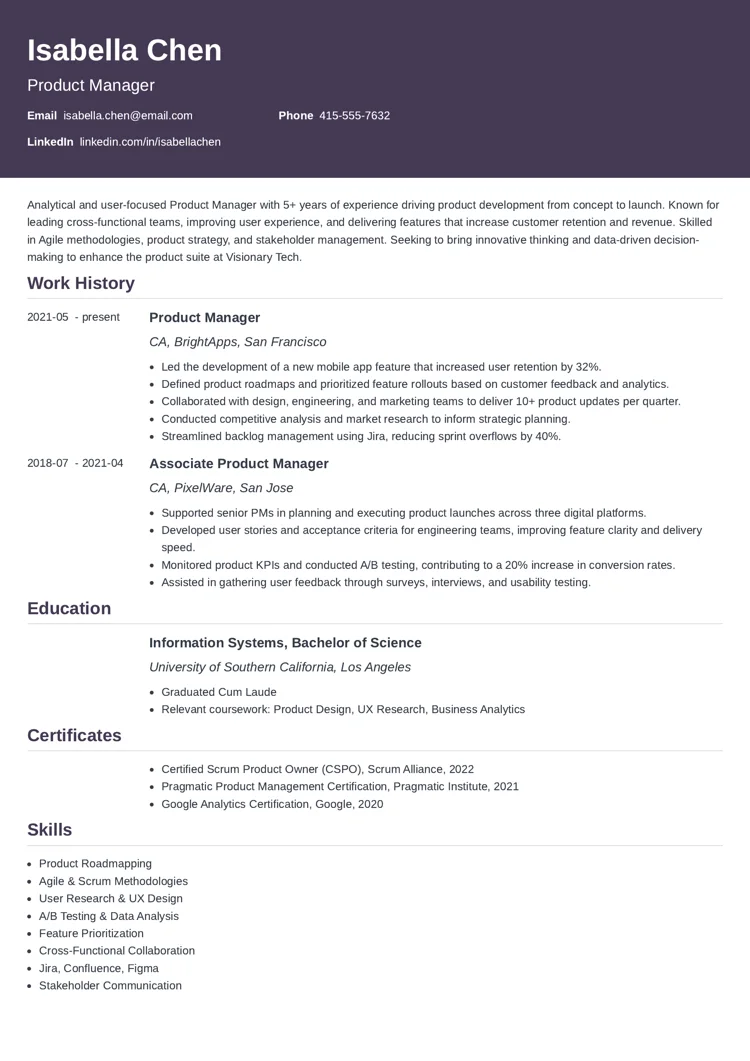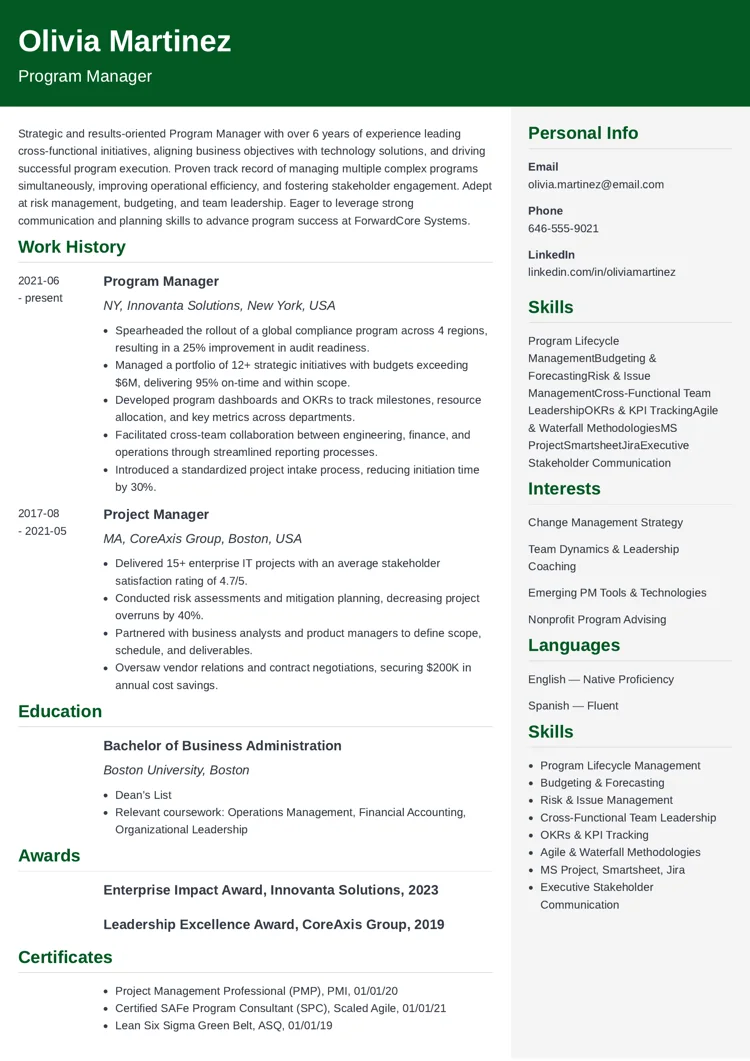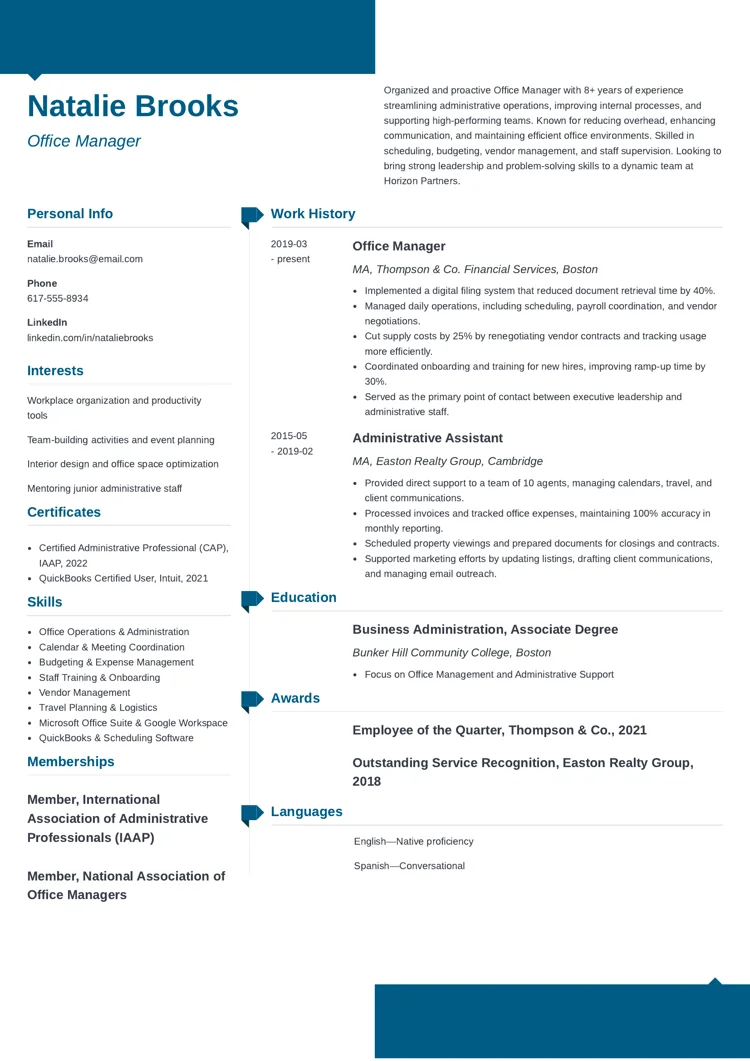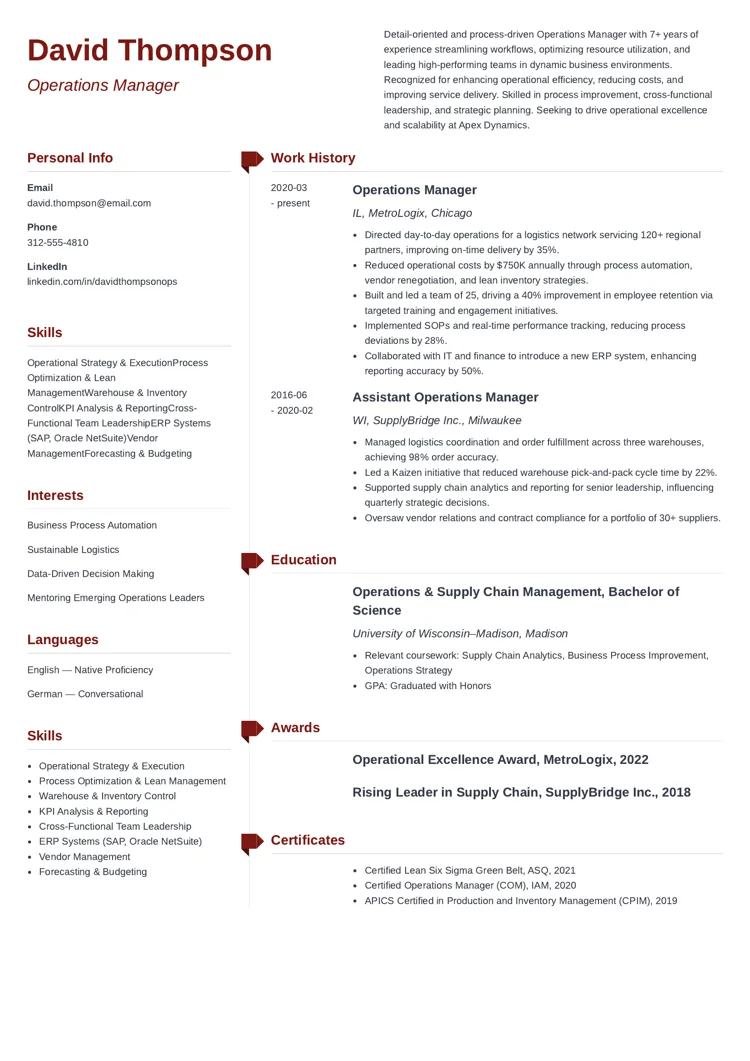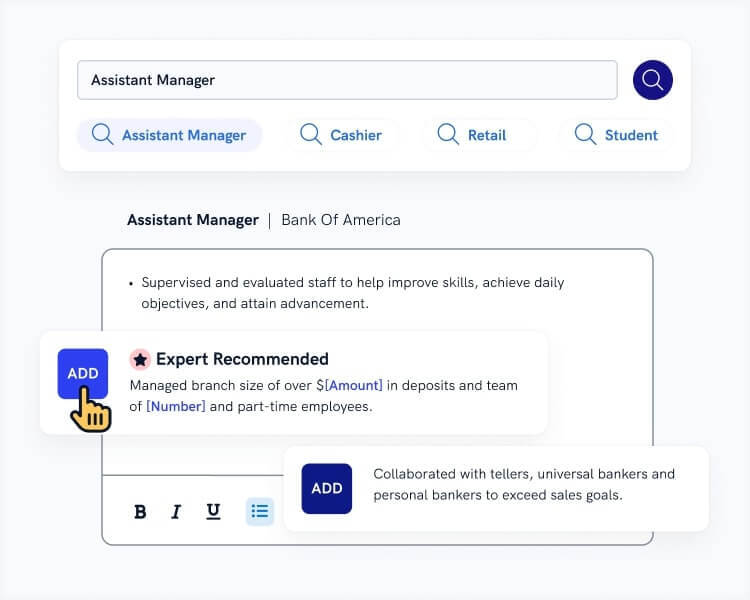Crafting a manager resume isn’t just about ticking boxes—it’s your chance to show you’re the one who makes things happen. You’ve led teams, juggled deadlines, and solved problems before they even existed—and now it’s time your resume reflects that.
Whether you're eyeing your next big promotion or stepping into management for the first time, we’ll show you how to build a resume that shouts “leader” from the top down.
Top Article Insights:
- Manager resume example & template to copy & paste.
- Resume examples for computer science internships, engineering internships, accounting internships, and more!
- Step-by-step guide on how to write a manager resume.
Manager Resume Example
Manager Resume Template to Copy & Paste (Text Version)
Avery Bennett
Marketing Manager
646-555-0198
avery.bennett@email.com
linkedin.com/in/averybennett
Summary
Strategic Marketing Manager with 6+ years of experience driving brand growth, digital engagement, and multi-channel campaign success. Known for increasing online conversion rates by 28% and leading cross-functional teams to execute high-impact marketing strategies. Skilled in SEO/SEM, content marketing, campaign analytics, and team leadership. Seeking to bring data-driven insights and creative direction to BrightSpark Media to elevate brand presence and market performance.
Experience
Marketing Manager
NextWave Digital, New York, NY
March 2021–Present
- Led the launch of a rebranding campaign that boosted website traffic by 35% and improved customer retention by 18%.
- Managed a $400K annual marketing budget, allocating resources to maximize ROI across digital and traditional channels.
- Oversaw a team of 6 marketing professionals, improving team productivity by 22% through streamlined workflows and regular performance reviews.
- Implemented A/B testing for email and ad campaigns, increasing CTR by 30% and improving campaign efficiency.
- Collaborated with product, sales, and creative teams to align messaging and boost lead quality.
Digital Marketing Specialist
Creative Hive Agency, Brooklyn, NY
May 2018–February 2021
- Planned and executed targeted content marketing strategies, generating a 40% increase in qualified leads.
- Optimized SEO strategies for client websites, leading to an average 50% boost in organic traffic.
- Managed paid ad campaigns across Google Ads and social platforms with a 20% average increase in ROI.
- Conducted detailed performance reporting, translating insights into actionable improvements.
Education
Bachelor of Business Administration in Marketing
New York University, NY
September 2014–June 2018
- Graduated with Honors
- Relevant coursework: Digital Marketing, Consumer Behavior, Strategic Brand Management
Skills
- Digital Marketing Strategy
- SEO/SEM Optimization
- Content Marketing & Social Media
- Google Ads & Meta Ads Manager
- Marketing Automation (HubSpot, Mailchimp)
- Campaign Performance Analytics
- Budget Management
- Leadership & Team Collaboration
Certifications
- Google Ads Certification, Google, 2023
- HubSpot Inbound Marketing Certification, HubSpot Academy, 2022
- Meta Certified Digital Marketing Associate, Meta Blueprint, 2022
Awards & Honors
- Marketing Leader of the Year, NextWave Digital, 2022
- Top Campaign Performance Award, Creative Hive, 2020
Memberships
- Member, American Marketing Association (AMA)
- Member, Digital Marketing Institute (DMI)
Languages
- English—Native proficiency
- Italian—Intermediate
Interests
- Trend forecasting and brand storytelling
- User behavior and digital psychology
Project Manager Resume Example
What Do I Think About This Example? (Expert Tips)
Cascade is a sleek, modern resume template designed for clarity and visual balance. It effortlessly guides the reader’s eye from section to section without overwhelming them. And those visual skill indicators? A smart touch that gives your qualifications an extra edge at a glance.
Find out more: Project Manager Resume Example
Product Manager Resume Example
What Do I Think About This Example? (Expert Tips)
Diamond brings a subtle flair to traditional formatting. Instead of standard bullets, it uses refined diamond-shaped icons to mark each achievement, adding visual interest without going overboard. It’s a favorite when you want your resume to feel polished and a bit more original.
Find out more about: Product Manager Resume Example
Program Manager Resume Example
What Do I Think About This Example? (Expert Tips)
Influx template combines style and function with ease. Its bold header instantly puts your name and contact info in the spotlight—exactly where it belongs. If you want to leave a strong first impression, this template helps ensure you’re remembered.
Find out more about: Program Manager Resume Example
Office Manager Resume Example
What Do I Think About This Example? (Expert Tips)
Muse template takes a bold step with a two-column structure and layered visual elements. You might think it sounds too fancy, but give it a look—it’s incredibly clean and intuitive. A perfect example of design that’s both creative and practical.
Find out more about: Office Manager Resume
Operations Manager Resume Example
What Do I Think About This Example? (Expert Tips)
Valera template is a celebration of typography done right. With clean, stylish fonts as its main feature, it stands out without using flashy icons or unusual layouts. If you want your resume to feel distinct and professional, Valera’s your go-to.
Learn more: Operations Manager Resume
Looking for a specific management position? See:
- Marketing Manager Resume
- General Manager Resume
- HR Manager Resume
- IT Manager Resume
- Relationship Manager Resume
- Restaurant Manager Resume
- Retail Manager Resume
- Sales Manager Resume
If you haven't found what you are looking for, check our amazing selection in our list of Resume Examples.
Creating a resume with our builder is incredibly simple. Follow our step-by-step guide and use content from Certified Professional Resume Writers to have a resume ready in minutes.
When you’re done, Zety’s resume builder will score your resume and our resume checker will tell you exactly how to make it better.
How to Write a Manager Resume?
Allow me to show you how to write an impressive, job-winning management resume. Below you’ll find all the expert tips you need to succeed. But first, it’s time for some trivia regarding managers' resumes, based on the data gathered from over 11 million (!) resumes users created with our resume builder.
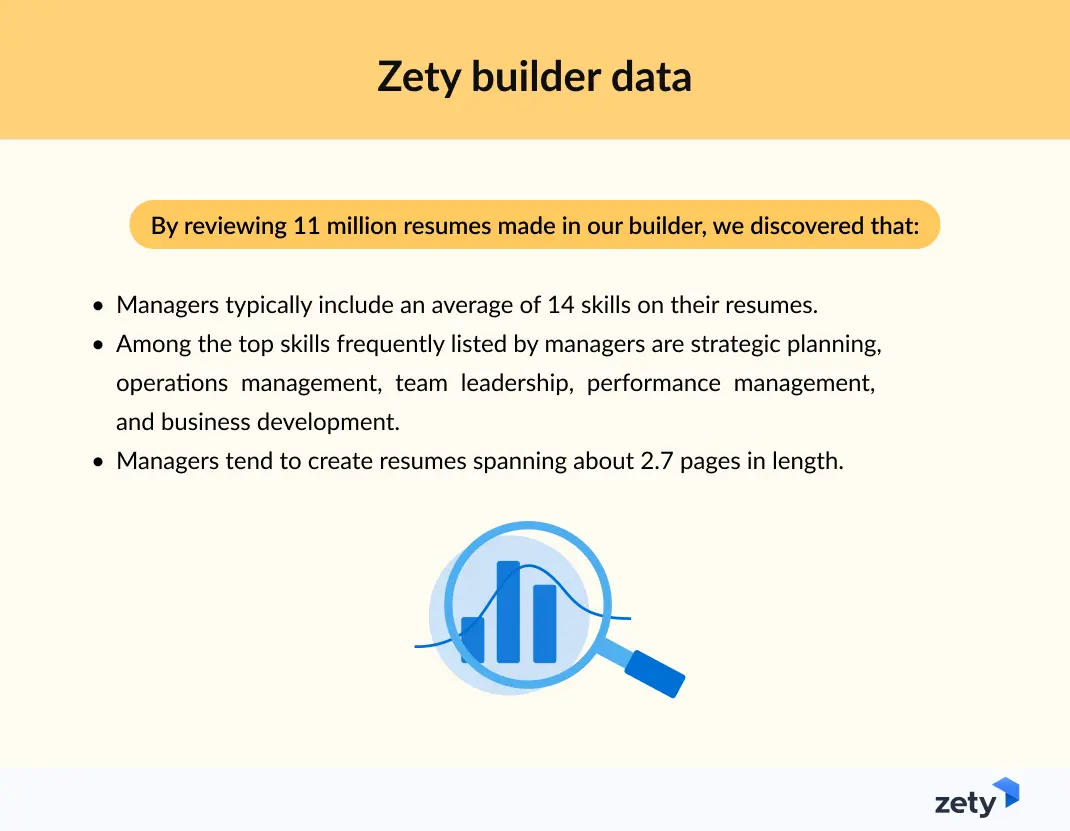
1. Format Your Manager Resume to Reflect Your Professionalism
As a manager, your role involves clarity, structure, and strategy—and your resume should be no different. A well-organized resume layout that highlights your leadership experience and results-driven mindset sets the tone from the very first glance. It shows recruiters you understand what it means to lead with intention and purpose.
Here’s how to format your resume:
- Include the following resume parts:
- Resume Header (with your name, job title, contact information, and LinkedIn profile)
- Resume Profile
- Experience
- Education
- Skills
- Additional Sections
- Select a professional font for your resume and set its size to 11–12 points.
- Apply the 1.5 line spacing and set one-inch resume margins.
- Stick to the right length of your resume. One page is a traditional one, but with managerial experience, you might want to aim for a two-page resume.
- Name your resume correctly, using your name, job title, and the word “resume.”
- Save your document in PDF file format unless the job ad requires a different one.
Pro Tip: Select a modern resume template. It will help you create your resume faster and easier.
2. Show Management Experience on Your Resume
You’ve likely led teams through complex projects. Now’s the time to let that relevant experience shine in your work history section. Don’t just list responsibilities—highlight how you made an impact. Recruiters want to see results, decisions, and leadership in action.
Here’s how to do it right:
- Write using the chronological resume format. It’s the one preferred by recruiters.
- Include the companies’ names, your job titles, and the dates of your employment.
- Try to avoid listing your management duties. Focus on your impressive accomplishments.
- Use bullet points to show these accomplishments, but limit them to six.
- Begin each of these bullets with a strong action verb to boost the readability of your resume.
- Quantify your accomplishments whenever possible to prove you have followed the impact of your work.
Marketing Manager
NextWave Digital, New York, NY
March 2021–Present
- Led the launch of a rebranding campaign that boosted website traffic by 35% and improved customer retention by 18%.
- Managed a $400K annual marketing budget, allocating resources to maximize ROI across digital and traditional channels.
- Oversaw a team of 6 marketing professionals, improving team productivity by 22% through streamlined workflows and regular performance reviews.
- Implemented A/B testing for email and ad campaigns, increasing CTR by 30% and improving campaign efficiency.
- Collaborated with product, sales, and creative teams to align messaging and boost lead quality.
Learn more about what experience matters most. Visit our guide: Relevant Experience on a Resume
3. Make Your Education Section Count on Your Management Resume
Your academic background may not be the focus of your resume anymore, but it still plays a role in defining your expertise. Whether you’ve got a degree in business, engineering, or the arts, the right educational details can complement your professional story and reinforce your credibility.
Here’s how to do it right:
- Include:
- Earned Degree
- Minors and Majors
- School Location
- Graduation Date
- Consider also including the following:
- Extracurricular Activities
- Relevant Coursework
- Significant GPA (equal to or higher than 3.5)
- Dean’s List
- Phi, Beta, Kappa
- Cum Laude
- Studying Abroad
Bachelor of Business Administration in Marketing
New York University, NYSeptember 2014–June 2018
- Graduated with Honors
- Relevant coursework: Digital Marketing, Consumer Behavior, Strategic Brand Management
Still learning? This guide is for you: How to List Continuing Education on a Resume
4. Highlight the Right Skills on Your Manager Resume
As a manager, you need a well-rounded skill set that balances professional know-how with people skills. Show recruiters that you’re not just task-oriented—you’re a strategic thinker, a motivator, and a problem-solver. The right mix of hard and soft skills can tip the scale in your favor.
These are the key manager skills to consider:
5. Include More Information to Set You Apart From Other Managers
Great managers do more than manage—they innovate, grow, and lead by example. Additional resume sections can showcase those extra layers of expertise and leadership. When used wisely, these additions can position you as the candidate to beat.
Certifications
- Google Ads Certification, Google, 2023
- HubSpot Inbound Marketing Certification, HubSpot Academy, 2022
- Meta Certified Digital Marketing Associate, Meta Blueprint, 2022
Awards & Honors
- Marketing Leader of the Year, NextWave Digital, 2022
- Top Campaign Performance Award, Creative Hive, 2020
Memberships
- Member, American Marketing Association (AMA)
- Member, Digital Marketing Institute (DMI)
Languages
- English – Native proficiency
- Italian – Intermediate
Interests
- Trend forecasting and brand storytelling
- User behavior and digital psychology
A standout resume doesn’t just list qualifications—it tells a story. It reveals your personality, work ethic, and values in a way that shows employers not just what you can do, but who you are as a professional.
6. Write a Manager Resume Summary That Sells Your Strength as a Leader
Your resume introduction is your elevator pitch—you only get 7 seconds to sell yourself. A resume summary should capture your leadership style, years of experience, and the key accomplishments you’re proud of, all in just a few lines. This is where you prove that you’re not just another manager, but a high-impact professional who gets results.
Here’s a formula that will help you do it right:
Adjective + Job Title+ Years of Experience + Achievements + Skills + What You Want to Do for the Employer
Strategic Marketing Manager with 6+ years of experience driving brand growth, digital engagement, and multi-channel campaign success. Known for increasing online conversion rates by 28% and leading cross-functional teams to execute high-impact marketing strategies. Skilled in SEO/SEM, content marketing, campaign analytics, and team leadership. Seeking to bring data-driven insights and creative direction to BrightSpark Media to elevate brand presence and market performance.
Pro Tip: Write this part last, once all the information necessary to create an outstanding resume profile is already present in your resume.
7. Add a Cover Letter to Your Entry-Level Resume and Keep Impressing Your Future Employer
For management roles, a strong cover letter is more than a formality—it’s your opportunity to convey strategic thinking, vision, and cultural fit. It shows that you’re proactive, invested, and ready to contribute at a higher level. A well-crafted letter can elevate your application from qualified to exceptional.
Follow the following cover letter advice:
- Create a professional cover letter header that includes both your and your recipient’s information and the date of writing.
- Open with a polite cover letter salutation to make a great first impression.
- Write a captivating cover letter beginning. Explain who you are and what position you are applying for.
- Be sure to mention the company’s name. That’s how you make it personal from the top.
- List your impressive achievements, but focus on what’s most relevant to the job you’re after.
- Offer a precise place and time for your interview at the end of your cover letter.
- Sign your cover letter and repeat your contact details
Here’s a sample opening:
Dear Harper,
As a seasoned marketing manager with over six years of experience building campaigns that drive results, I was excited to see the opening at BrightSpark Media. Your brand’s creative energy and digital-first approach have always impressed me, and I’d be thrilled to bring my strategy-focused mindset and performance-driven approach to your team.
Learn more about how to ace it: Manager Cover Letter for 2025
Plus, a great cover letter that matches your resume will give you an advantage over other candidates. You can write it in our cover letter builder here. Here's what it may look like:
See more cover letter templates and start writing.
Expert Curated Video Content
Here’s Caio, our Certified Professional Resume Writer explaining how to write a resume in just five minutes!
About Zety’s Editorial Process
This article has been reviewed by our editorial team to make sure it follows Zety's editorial guidelines. We’re committed to sharing our expertise and giving you trustworthy career advice tailored to your needs. High-quality content is what brings over 40 million readers to our site every year. But we don't stop there. Our team conducts original research to understand the job market better, and we pride ourselves on being quoted by top universities and prime media outlets from around the world.
